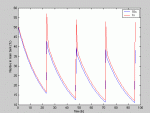Both reasons make sense at the first glance. However, I think that they do not stand to a close quantitative scrutiny (see below):
wade":6so2dj7n said:
I would say the largest reason is for aeration in the main tank. Movement of water down to the sump, thru skimmer, and back provides a great deal of CO2 removal and oxygenation to the tank.
Tanks can go skimmerless and without a sump as long as you break the surface to allow for the air exchange. This leads to the conclusion that an overflow and a skimmer doesn't improve the situation much irrespective
of the flow rate. If it would be to put some numbers up they will probably look like: sufficient aeration 50%, aeration without overflow: 70%, aeration with sump and skimmer at 1x: 99.5%, aeration with skimmer and sump at 10x: 99.7%.
The point is that the last 0.2% is truly not needed.
I would also contend that you should flow more than the skimmer can take in, in order to not "waste" effort on the part of the skimmer. (ie- if the skimmer removes what it can from the sump, theoretically of course, then you want that volume being replaced by 'dirty' water from above at least as fast as the skimmer can take it in.
I think that this is the same as the previous one: it will probably produce a 0.1% improvement in the skimmer efficiency, but not more. That is unless you get really big spikes (e.g., say you drop a bottle of Windex in the tank and you want all water to go through the skimmer as fast as possible - assuming the skimmer gets the Windex out - which I doubt, but just to make the point). Other than that, the skimmer at 1x will make the water very clean before the return pump sends it back up, so you'll have like a nice "water change", as opposed to just "slightly better water" that results from the 10x. I'm sure I can write the equations if needed, but I think that you get the intuition from what I'm saying.
The argument for CO2 is on a similar rational, but it's stronger than for the waste removal: the CO2 removal has a maximum that you cannot go over, while for the skimmer the assumption is that you can always remove more if you skim more.
Mihai






